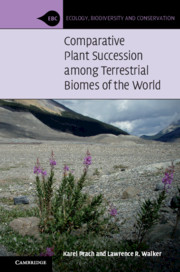Book contents
- Comparative Plant Succession among Terrestrial Biomes of the World
- Ecology, Biodiversity, and Conservation
- Comparative Plant Succession among Terrestrial Biomes of the World
- Copyright page
- Contents
- Preface
- 1 Introduction
- Part I Plant Succession and Biomes
- Part II Succession by Disturbance Type
- 4 Comparative Approach
- 5 Volcanoes
- 6 Glaciers
- 7 Cyclones
- 8 Dunes
- 9 Landslides
- 10 Floods
- 11 Fire
- 12 Clearcuts
- 13 Plowed Fields
- 14 Mines
- 15 Other Disturbances
- Part III Synthesis
- Book part
- References
- Index
15 - Other Disturbances
from Part II - Succession by Disturbance Type
Published online by Cambridge University Press: 08 May 2020
- Comparative Plant Succession among Terrestrial Biomes of the World
- Ecology, Biodiversity, and Conservation
- Comparative Plant Succession among Terrestrial Biomes of the World
- Copyright page
- Contents
- Preface
- 1 Introduction
- Part I Plant Succession and Biomes
- Part II Succession by Disturbance Type
- 4 Comparative Approach
- 5 Volcanoes
- 6 Glaciers
- 7 Cyclones
- 8 Dunes
- 9 Landslides
- 10 Floods
- 11 Fire
- 12 Clearcuts
- 13 Plowed Fields
- 14 Mines
- 15 Other Disturbances
- Part III Synthesis
- Book part
- References
- Index
Summary
In Chapters 5‒14, we discussed 10 widely distributed disturbances and compared successional processes among biomes following each disturbance. We chose disturbances that had been sufficiently studied to permit an analysis of the scientific literature at a global scale. We kept our categories of disturbance as broad as possible to incorporate many related studies. For example, under volcanoes, we included lava, tephra, pyroclastic flows, debris avalanches, and lahars. Under landslides we included slides, flows, and falls of rock, regolith, and sediments. Under mines we included extraction of coal, rock, peat, sand, and the waste piles from these extractions. Yet the complexity of disturbances and their myriad interactions make any categorization somewhat arbitrary and incomplete: arbitrary because one could argue for different categories (e.g., we divided wind damage into dunes and cyclones but pooled all volcanic disturbances and pooled all fire-damaged ecosystems); incomplete because certain disturbances are inevitably left out. For example, under cyclones we did not address individual tree falls; under floods we focused on rivers but did not address flood zones of ocean beaches, lakeshores, or reservoirs; under fire we largely ignored low-intensity fires; while under clearcuts we did not address selective cutting or treatments followed by planting or seeding. Thus, our focus has been on disturbances that were illustrative of general successional principles without attempting a comprehensive review of all terrestrial disturbances.
- Type
- Chapter
- Information
- Publisher: Cambridge University PressPrint publication year: 2020

